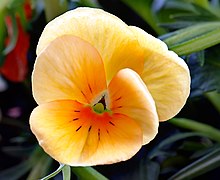Pansy
As pansy refers to a group of species from the genus of the violet ( Viola ) within the family of Violet Family (Violaceae), which are distinguished by the mutual coverage of the petals: The broad bottom Kronblatt , the "step-mother" partially covers the side, the "daughters", and these in turn the top two, the "stepdaughters". Another common characteristic of the pansies is that they have large stipules . The less common name Pensee comes from the French (herbe de la) pensée "plant of remembrance". The pansy is a symbol of remembrance, memory.
Types (selection)
- Altai pansy ( Viola altaica )
-
Field pansy ( Viola arvensis )
- Common field pansy ( Viola arvensis subsp. Arvensis )
- Large-flowered field pansy ( Viola arvensis subsp. Megalantha )
- Dune pansy ( Viola tricolor var.maritima )
- Yellow calamine pansy ( Viola calaminaria )
- Spurred Pansy ( Viola calcarata )
- Horned violet ( Viola cornuta )
- Violet calamine pansy ( Viola guestphalica )
- Steppe pansy ( Viola kitaibeliana )
- Sudeten pansy ( Viola lutea )
-
Wild pansy ( Viola tricolor )
- Dune pansy ( Viola tricolor var.maritima )
- Rock pansy ( Viola tricolor subsp.saxatilis )
- Mountain Meadow Pansy ( Viola tricolor var.polychroma )
- Common wild pansy ( Viola tricolor var.tricolor )
- Garden pansy ( Viola wittrockiana Gams ex Nauenburg & Buttler )
Garden pansy
From numerous crossings of the wild pansy ( Viola tricolor ) with other species and Auslese, the cultivated forms, the garden pansy ( Viola × wittrockiana ), which bloom from March to November, are cultivated as annuals or biennials and of which there are now a large number, arose Choice of colors and shapes there.
The name of the Swiss giant refers to the large flowers of these varieties, new are miniature pansies from the cross between garden pansies and horned violets and double shapes.
Cultivation
Soil: Moist, permeable to water, relatively fertile
Sun: Full sun or partial shade.
Sowing: In late summer
Others

The pansy, also known as the Christ eye , is the symbol of the free thinkers in France and Austria. It was the symbol of good thoughts as early as the Middle Ages .
The pansy is also one of the urban symbols of the Japanese city of Osaka .
It contains salicin .
literature
- Friedrich Dietert: Our garden pansy , Geest & Portig, Leipzig 1952








